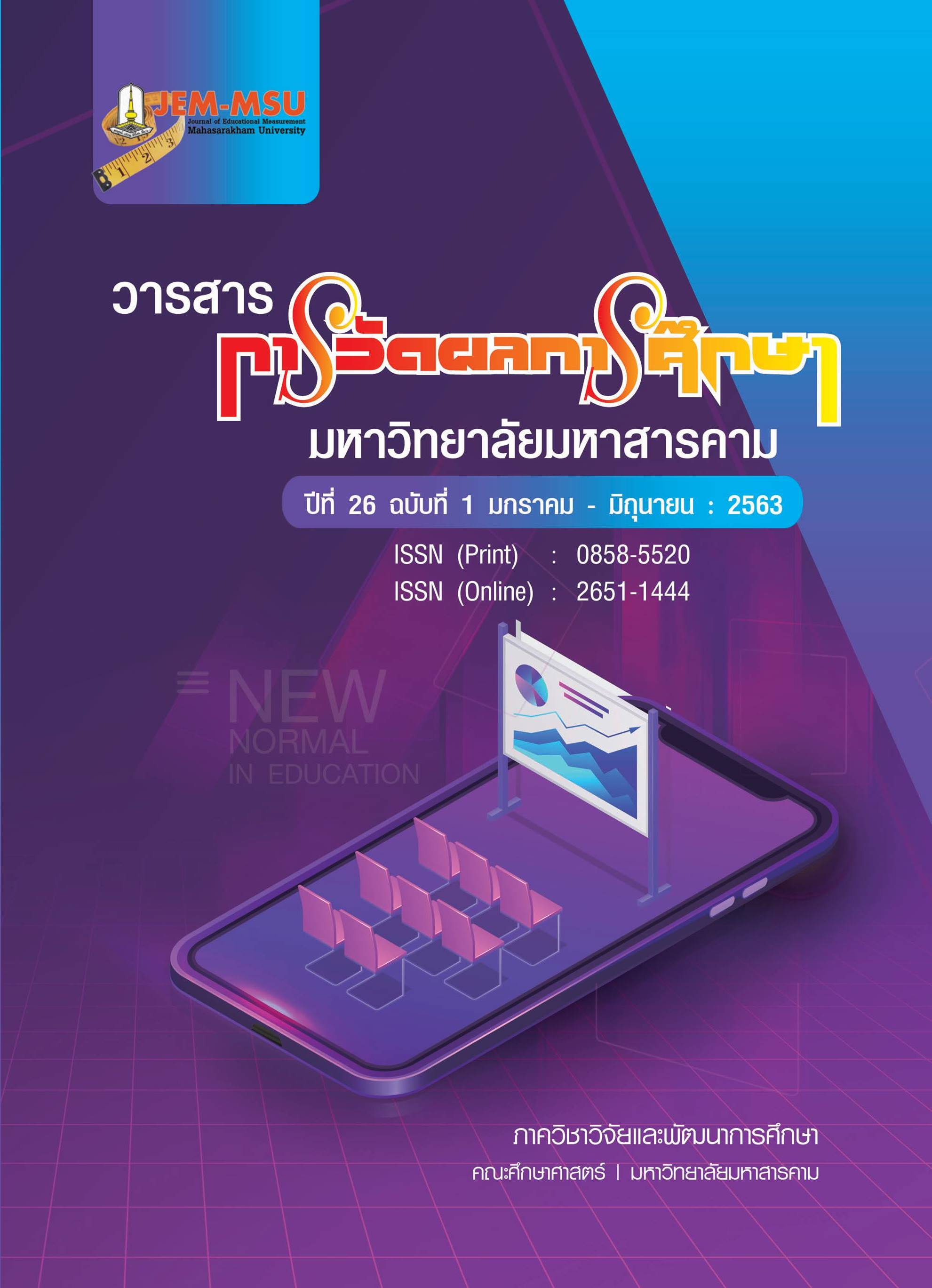Evaluation of Inclusive Education of Vocational Education and Higher Secondary Education (Dual Education) in the Schools under the Secondary Education Service Area Office 23, Sakon Nakhon Province
Main Article Content
Abstract
This research aimed to evaluate the inclusive education of vocational education and higher secondary education under the Secondary Education Service Area Office 23 in Sakon Nakhon Province on 3 topics: input; process; and problems, obstacles, and suggestions. The sample consisted of 7 school administrators, 7 project coordinators, 23 teachers, 35 students and 6 parents, totally 78, acquired through stratified random sampling. The tools used for collecting data were of 3 types: 2 questionnaires in 5-point rating scale, one for administrators, coordinators and teachers, with the discrimination from 0.31 to 0.80 and the reliability of 0.91; and the other for students, with the discrimination from 0.31 to 0.71 and the reliability of 0.86; a 6-item structured observation; and 4 structured interview forms: 1) 13-item form for school administrators, 2) 12-item for coordinators and teachers, 3) 10-item for students, and 4) 9-item for parents. Data analysis employed percentage, the mean, standard deviation and content analysis.
The results of the research were as follows:
1. Regarding the input, it was found that the participants had their opinion in the dual education project, as a whole, at a high level (= 4.23). From observations and interviews, it was found that the teachers were well-prepared and were cognizant of organizing learning and teaching activities; the students were attentive, interested and enthusiastic. However, there were some classrooms that were not suitable enough for learning activities. They lacked media, equipment and learning sources.
2. Regarding the process, it was found that the participants had their opinion in the dual education project, as a whole, at a high level (= 4.26). From observations and interviews, it was found that the activities in the dual education project were carried out in accordance with the policy. The committee had coordination, meetings and participation in planning to solve problems during the course of the project. On the part of the learners, they had hands-on experience of vocational skills.
3. Regarding the state of problems and suggestions, it was found that the main problems were the lack of budget for management, the shortage of personnel, the lack of media, tools, equipment, and classrooms, traveling a long distance to the partner school, delayed coordination, and organizing student care system to cope with students’ participation in the activities carried out at the same time in both educational institutions, which affected the students. There was also the problem of student adjustment due to studying of two courses simultaneously, making the workload bigger than regular classes. Assignments and job submissions in two locations needed proper time allotment and responsibility. In terms of recommendations, it was found that: 1) There should be a clear and suitable system of caring for students who are in the dual education project, that deals with organizing co-curricular activities of the school and the vocational institution that are partners, approved by both partners; 2) There should be a survey of learners' needs and preparation on every aspect before enrollment in each subject area; 3) Students should be enrolled according to their needs. There should not be enrollment by class or merging classes because there are some students who come to study unintentionally; 4) Execution of the dual education project should receive additional budget, media, materials, and additional equipment by considering the readiness and suitability of each school, establishment and the needs of students; and 5) To help students, scholarships and quotas to continue to study at a higher level should be provided.
Article Details
The content and information contained in the published article in the Journal of Educational Measurement Mahasarakham University represent the opinions and responsibilities of the authors directly. The editorial board of the journal is not necessarily in agreement with or responsible for any of the content.
The articles, data, content, images, etc. that have been published in the Journal of Educational Measurement Mahasarakham University are copyrighted by the journal. If any individual or organization wishes to reproduce or perform any actions involving the entirety or any part of the content, they must obtain written permission from the Journal of Educational Measurement Mahasarakham University.
References
กลุ่มส่งเสริมการจัดการศึกษา (สพม.23). (ม.ป.ป.) ประชุมประจำเดือน. [ออนไลน์]. ได้จาก : www.sesarea23.go .th/ web/ [สืบค้นเมื่อ วันที่ 9 กันยายน 2559]
เกษม วงษ์ชัย. (2554). การศึกษาสภาพปัญหาและความต้องการในการเรียนการสอนวิชางานฝึกฝีมือ สาขาวิชาเทคนิคพื้นฐาน สถาบันการอาชีวศึกษาภาคตะวันออกเฉียงเหนือ 5 และภาคกลาง 2. มหาวิทยาลัยเทคโนโลยีพระจอมเกล้าธนบุบรี/กรุงเทพฯ.
บุญชม ศรีสะอาด. (2553). การวิจัยเบื้องต้น. พิมพ์ครั้งที่ 8. กรุงเทพฯ : สุวีริยาสาส์น,.
บุญตา แซ่เล็ก. (2557). การประเมินโครงการห้องเรียนเทคโนโลยีตามความร่วมมือระหว่างมหาวิทยาลัยมหาสารคามกับโรงเรียนท่าขอนยางพิทยาคม โดยใช้รูปแบบการประเมิน 360 องศา. วิทยานิพนธ์ปริญญาการศึกษามหาบัณฑิต สาขาวิชาหลักสูตรและการสอน คณะศึกษาศาสตร์ มหาวิทยาลัยมหาสารคาม.
รวิกรานต์ นันทเวช. (2557). การพัฒนารูปแบบการจัดการศึกษาตลอดชีวิตเพื่อพัฒนาทักษะการปฏิบัติงานของแรงงานไทยสำหรับสถานประกอบการภาคอุตสาหกรรม. วิทยานิพนธ์ปริญญาครุศาสตรดุษฎีบัณฑิต สาขาวิชาการศึกษานอกระบบโรงเรียน ภาควิชาการศึกษาตลอดชีวิต คณะครุศาสตร์ จุฬาลงกรณ์มหาวิทยาลัย.
สำนักงานคณะกรรมการศึกษาขั้นพื้นฐาน. (2558). ระบบการศึกษาในประเทศไทย. [ออนไลน์]. ได้จาก: www.secondary.obec.go.th/ [สืบค้นเมื่อ 9 กันยายน 2559]
สำนักงานคณะกรรมการการอาชีวศึกษา. (2558). แนวทางการจัดการศึกษาหลักสูตรเรียนร่วมอาชีวศึกษาและมัธยมศึกษาตอนปลาย (ทวิศึกษา). กรุงเทพฯ : ส.ศรีวิไล.
สำนักวิชาการและมาตรฐานการศึกษา. (2559). แนวทางการจัดการเรียนร่วมหลักสูตรอาชีวศึกษาและมัธยมศึกษาตอนปลาย (ทวิศึกษา )ในสถานศึกษาสังกัดสำนักงานคณะกรรมการการศึกษาขั้นพื้นฐาน. กรุงเทพฯ : ชุมนุมสหกรณ์การเกษตรแห่งประเทศไทย จำกัด.
หน่วยศึกษานิเทศก์สำนักนโยบายและแผนการอาชีวศึกษา. (2558). แนวทางการจัดการศึกษาเรียนร่วมหลักสูตร อาชีวศึกษาและมัธยมศึกษาตอนปลาย (ทวิศึกษา). กรุงเทพมหานคร : หจก.ศรีวิไล.
อารีรัตน์ หาพันนา. (2556). การประเมินโครงการพัฒนาจิตอาสาของครูเพื่อเพิ่มคุณภาพการศึกษาด้วยกลยุทธ์ SBN : (Share Learn-Ba-Network) ของโรงเรียนในสังกัดสานักงานเขตพื้นที่การศึกษาประถมศึกษาอุบลราชธานี เขต 4. วิทยานิพนธ์ปริญญาการศึกษามหาบัณฑิต สาขาบริหารการศึกษา มหาวิทยาลัยมหาสารคาม.


